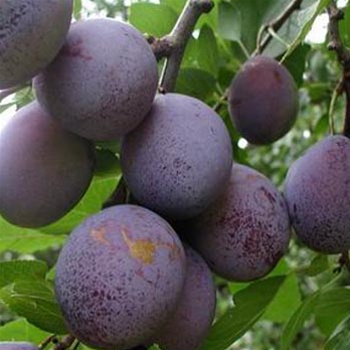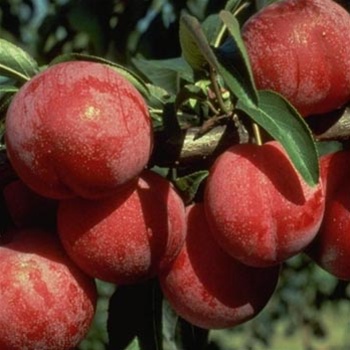Plum trees need full sun to produce sweet fruit and flower buds for the next growing season. They prefer well-drained, fertile, loamy soil rich in organic matter but are somewhat adaptable and forgiving. Mixing 25-50% compost into existing soil when planting will give trees a great head start.
‘Methley’ plum is an early, self-fertile Asian variety that produces medium-sized fruit with reddish-purple skin and red flesh. It has an excellent sweet, mild flavor and is a prolific producer.
‘Seneca’ plum has large, vibrant red fruits perfect for home orchards and commercial use. Blooms profusely with white spring flowers that attract pollinators, this tree is ideal for fresh eating, cooking, and preserving, ensuring a plentiful harvest from mid to late summer.
‘Yellow Egg’ European plums are egg-shaped, large and golden yellow inside and out. Called ‘Pershore Egg’ in England, the ‘Yellow Egg’ has often been seen only as a cooking plum but when properly ripened on the tree it rivals the sweetness of other fresh plums with a delicious honey flavor and tangy skin.
CLICK HERE to check current availability and preorder fruit trees on our webstore.
Plum trees are semi-dwarf, growing 15’ high x 15’ wide.
PLANTING: Amend soil by mixing up to 50% compost with existing soil.. Plant tree so soil level in container is level or slightly higher than surrounding soil. Water in to remove air pockets around roots and mulch with wood chips. The first season, water regularly to establish tree.
FERTILIZING: Adequate nutrition is essential for quality fruit production. The best thing you can do is top-dress with compost every year. A general rule of thumb for adding additional fertilizer is to apply a combined 2/3 pound of bone meal and 1/3 Texas greensand to each tree the first year, double that the second year, and triple the third and subsequent years. Fertilizer should be broadcast on the soil surface around the drip line of the tree. The “drip line” is the circular line at the outer ends of the branches.
SCAFFOLD TRAINING: Improperly trained fruit trees have very upright branch angles which can result in excessive vigor and serious limb breakage under a heavy fruit load. Larger branches can be spread out using short wooden boards with a notch cut in each end to catch the branch. Hanging weights on branches or tying it down with string wrapped loosely around the limb are other useful methods for spreading branches. All upright growth from scaffold branches should be pulled down to a horizontal position or removed.
PRUNING: Prune in June. Pyramidal form is best. Once trees have reached 12-15’, restrict pruning to new growth not bearing fruit this year.
FRUIT THINNING: When the largest fruit are as large as a quarter, fruits should be removed by hand so that the remaining plums are spaced about every 8 inches. Fruit thinning will allow the remaining fruit to develop and prevent damage to the tree.


